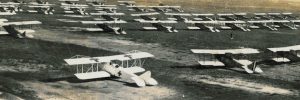By Sam Daleo
Read the full September issue of Viewpoints.
On April 6, 1917, the U.S. declared war on Germany and officially entered World War I. American forces were not fully engaged in the war until the spring offensive of 1918, however. Also in the spring of 1918, President Woodrow Wilson issued the first of two executive orders creating the Army Air Service.
These events soon impacted Carroll Ward, Mamie McFaddin’s future husband. Carroll entered the Army Air Service (the exact date is unknown) and began primary flight training as a combat pilot. It is unclear where this took place, but possibly at Kelly Field, in San Antonio, as the majority of American pilots in World War I learned to fly there. Many candidates completing primary training at Kelly went on to Ellington Field, in Houston, to begin advanced flight training. It was at Ellington Field that Carroll was discharged from Training Squadron N of the Army Air Service on March 12, 1919.
We do know that the airplane Carroll flew during this period was the Curtiss JN-4 two-seat biplane. The “Jenny,” as it was called by its crews, was America’s most famous and significant World War I airplane and the primary trainer aircraft of the Army Air Service. Over 7000 were used to train 95% of all American and Canadian pilots.
The Jenny was a traditionally designed biplane of the period, possessing a 44-foot unequal span, staggered wing arrangement. Ailerons were placed only on the upper wings and were operated using a wheel-type control system. The single, 90 HP Curtiss OX-5 eight-cylinder inline engine was located in the nose of the slim 27-foot fuselage and propelled the Jenny to a top speed of 75 MPH and a service ceiling of 6,500 feet. The fuselage also contained two inline cockpits, one in the front for the student, one in the rear for the instructor. Both cockpits were open-air, with only a small windscreen at the front for protection. A “tail-dragger,” the JN-4 was outfitted with a two-wheeled undercarriage in front and a wooden skid in back, under the tail unit. She was reliable, easy to fly, and loved by pilots and instructors alike.
The Jenny was built by the Curtiss Aeroplane and Motor Company, which was the largest aircraft manufacturer in the world during WW1. Curtiss employed 21,000 workers at its plants in Buffalo and Hammondsport, New York, and produced 10,000 aircraft and 15,000 aircraft engines during the war. For this achievement, company founder Glenn H. Curtiss is also remembered today as the founder of the American aircraft industry.
Curtiss began as a manufacturer of motorcycles, competing with such firms as Harley-Davidson and Indian, but by 1911, motorcycle manufacturing at the company had given way to aircraft. The Curtiss Company became a direct competitor of aircraft manufacturers both in the U.S. and around the world, including the Wright brothers. On July 5, 1929 the Curtiss Aeroplane and Motor Company and Wright Aeronautical merged to create the Curtiss-Wright Corporation, a leader in the aerospace industry to this day.
The Jenny was certainly one of the Curtiss Company’s early successes, and its story did not end with Armistice Day. The Barnstorming era, from 1919 until the late 1920’s, found the Jenny thrilling spectators at traveling aerial pageants and shows throughout the U.S. Even before Carroll Ward sat in his first Jenny, the plane had received some notoriety when it was “recruited” by General Pershing to assist his 1916 “punitive expedition” to Mexico in pursuit of Pancho Villa.
Luckily for Carroll, the war ended before he actually saw combat. His time in the Army Air Service, however, may have made a positive impression on Ida and W.P.H. McFaddin, Mamie’s parents. Until this time, they had disapproved of him because he had a “wild” reputation. On May 21, 1919, a little over two months after his discharge, he and Mamie were married in the parlor of the McFaddin home.
[share title=”love it, share it!” socials=”facebook, twitter, google, pinterest, bookmark” ]


 Collections Corner: Love, Madness and Secrets Kept
Collections Corner: Love, Madness and Secrets Kept